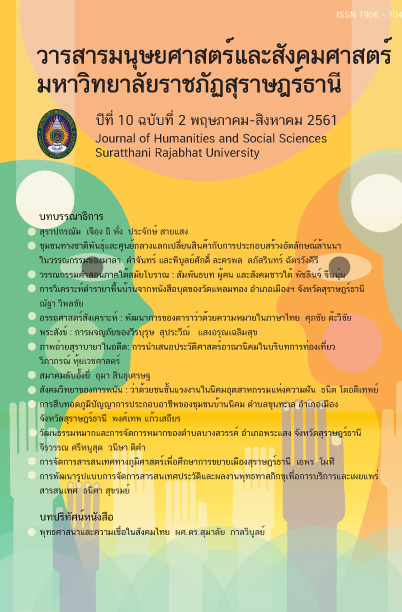วัฒนธรรมหมากและการจัดการหมากของตำบลบางสวรรค์ อำเภอพระแสง จังหวัดสุราษฎร์ธานี
Main Article Content
บทคัดย่อ
งานวิจัยเรื่องวัฒนธรรมหมากและการจัดการหมากตำบลบางสวรรค์ อำเภอ พระแสง จังหวัดสุราษฎร์ธานี มีวัตถุประสงค์เพื่อสำรวจ ศึกษา ลักษณะของหมากและการมีอยู่ของหมาก วัฒนธรรมหมากและการจัดการหมากของตำบลบางสวรรค์ในปัจจุบัน และเพื่อหารูปแบบการจัดการหมากที่นำไปสู่การเสริมสร้างคุณภาพชีวิต ใช้วิธีการศึกษาจากเอกสาร การเก็บรวบรวมข้อมูลภาคสนาม นำเสนอการวิจัยด้วยวิธีการพรรณนาวิเคราะห์ ผลการวิจัยพบว่า 1) ลักษณะของหมากและการมีอยู่ของหมากในตำบลบางสวรรค์มี 3 พันธุ์ คือ หมากพื้นเมือง หมากพันธุ์ใหม่ และหมากป่า แต่เดิมนิยมปลูกพันธุ์พื้นเมืองโดยปลูกปะปนไม้อื่นและปลูกเป็นแนวเขตแดนเพื่อใช้ในครอบครัว ภายหลังปลูกเป็นสวนแยกต่างหากจากพืชชนิดอื่น ปัจจุบันมีการปลูกทุกพื้นที่ชุมชนแต่ลดลงเนื่องจากชาวบ้านนิยมปลูกพืชเชิงเดี่ยวมากขึ้น 2) วัฒนธรรมหมากและการจัดการหมากของตำบลบางสวรรค์ในปัจจุบัน วัฒนธรรมหมากเข้ามาในพื้นที่นี้ผ่านการใช้ในชีวิตของผู้คน แสดงถึงความสัมพันธ์ระหว่างคนกับธรรมชาติในฐานะเป็นอาหารการกิน เป็นทรัพยากรในลักษณะสวนผสมผสาน เป็นสิ่งของเครื่องใช้ ใช้สร้างที่อยู่อาศัย ใช้รักษาโรค ใช้เป็นของเล่น แสดงถึงความสัมพันธ์ระหว่างคนกับสิ่งเหนือธรรมชาติ คือ ใช้ในพิธีกรรม ความเชื่อ และประเพณี และแสดงถึงความสัมพันธ์ระหว่างคนกับคน คือ ในฐานะสัญลักษณ์ของมิตรภาพ วิถีเศรษฐกิจพอเพียง ดำเนินอยู่มาถึงปัจจุบัน ด้านการจัดการหมากในปัจจุบันอยู่บนฐานของการส่งต่อ สืบทอดวิธีคิดจากบรรพบุรุษ การให้คุณค่า การใช้ประโยชน์ตามสมัยและความรู้ที่มีในรูปแบบการเรียนรู้ การอนุรักษ์ การผลิตซ้ำ และการจัดการความรู้ การจัดการทางเศรษฐกิจ การประยุกต์และสร้างสรรค์ การรวมกลุ่ม และการเชื่อมโยงกับภายนอกโดยมีคนในตำบลเป็นหลักในการจัดการบนฐานของความพอเพียง ปัญหาสำคัญ คือ การถูกแทนที่ด้วยความรู้ เทคโนโลยีสมัยใหม่ ความรู้เรื่องหมากและการจัดการเชิงบูรณาการบนฐานความเหมาะสมกับวิถีชีวิตกำลังลดลง 3) ด้านรูปแบบการจัดการหมากที่นำไปสู่การเสริมสร้างคุณภาพชีวิต เป็นรูปแบบที่ได้จากการสร้างกระบวนการเรียนรู้และกระบวนการมีส่วนร่วม ภายใต้การสังเคราะห์แนวคิดการพัฒนาของโครงการส่วนพระองค์สวนจิตรลดา แนวคิดการการพัฒนาที่ยั่งยืน แนวคิดเศรษฐกิจพอเพียง และแนวคิดการจัดการทรัพยากรวัฒนธรรมร่วมกับปรากฏการณ์การจัดการหมากที่เกิดขึ้น ได้รูปแบบการจัดการหมากซึ่งสามารถดำเนินการภายใต้การปฏิบัติและการสร้างการเรียนรู้ใน 2 รูปแบบอย่างเชื่อมโยงกัน คือ 1) รูปแบบการจัดการบนฐานชีวิตแบบองค์รวม/บูรณาการ/วัฒนธรรมหมาก ภายใต้การรักษา สืบทอด ต่อยอด ประยุกต์ สร้างสรรค์ ฟื้นฟู ทุกมิติให้เหมาะสมกับสภาพชุมชนและยุคสมัย และ 2) รูปแบบแหล่งเรียนรู้วัฒนธรรมหมากในฐานะแหล่งเรียนรู้ที่มีชีวิต
คำสำคัญ : วัฒนธรรมหมาก การจัดการหมาก ตำบลบางสวรรค์
Article Details
ต้นฉบับทุกเรื่องที่พิมพ์เผยแพร่ได้รับการตรวจสอบความถูกต้องทางวิชาการโดยผู้ทรงคุณวุฒิ (Peer Peview) เฉพาะสาขามนุษยศาสตร์และสังคมศาสตร์ การตีพิมพ์บทความซ้ำต้องได้รับการอนุญาตจากกองบรรณาธิการเป็นลายลักษณ์อักษร
เอกสารอ้างอิง
Arnan Kanjanaphan. (2006). Economic Culture in Economy without Culture. Bangkok : Kobfai Publishing Project.
Aramrat Duangchana. (1999). Southern People Intellect. Case Study of Somrom Garden. Suratthani Rajabhat University.
Agricultural Product Promotion and Management Office. Betel. Accessed on http://www.doae.go.th/library /html/detail/ futureofac /inde.htm on 15 march 2017
Chatthip Natsupha. (1997). Thai Culture and Social Change Process. 4th edition. Bangkok: Chulalongkorn University Printing House
Chatthip Natsupa and Phornpilau Lertwicha. (1998). Thai Village Culture. 2nd Edition. Bangkok: Sangsanbooks Co., Ltd.
Kongsakol Kawinraweeku. (2002). Constructing the body of Thai citizens during the Phibun regime of 1938-1944. Master of Arts Program in Sociology and Anthropology (Anthropology), Faculty of Sociology and Anthropology, Thammasat University.
Industrial Perennial Plant Group, Horticulture Promotion Division, Department of Agriculture Extension. (n.d.). Academic Paper on Commercial Betel Nut Growing. Bangkok: Department of Agriculture Extension.
Library, Sukhothai Thammathirat Open University. Betel. Accessed on https://library. stou.ac.th/odi/mak/page_1.html on 15 march 2017
Office of Royal Initiative Project and Special Affairs Group, Royal Forest Department. (Online). Princess Maha Chakri Sirindhorn giving royal speech on intellect and cultural resources. Available fromhttps://www.forest.go.th/orip/index.php?option=com_content&view=article&id=560&Itemid=505&lang=th. Retrieved 10 May 2017.
Phra Dhammapitaka (P. A. Payutto). (2006). Sustainable Development. 10th edition. Bangkok : Komolkeemthong Foundation.
Phornsak Phromkeaw. (Editor). (1991). Native Locality and Southern Region. The Institute for Southern Thai Studies, Srinakharinwirot University. Bangkok: Amarin printing group.
Prawet Wasee. (1998). Cultural Investment. Vision of Cultural Experts. (P. 45-55). Bangkok: Kansatsana Printing House
Provincial Information Office, Ramkhamhaeng University Sukhothai Campus in Honour of His Majesty the King. Betel. Accessed on http://www.info.ru.ac.th/province/ Sukhotai/srjsd11-4.htm on 15 march 2017
Thep Detsuwan. (2013). Betel Vine Culture. Nakhon Si Thammarat Journal. Year 43. Volume 2. February 2013.
Themjit Phungsomjot. (2001). “Betel” in Thai Culture and Word. 30 Thai Khadi Research Institute. Thammasat University. Bangkok: Charoen Pokphand Group.
Sayan Praicharnjit. (2007). Archaeological resources management in community development work. 3rd Edition Bangkok: Saksopha Printing.
Srisak Wanliphodom. (2011). Social-Thai Culture Development. Bangkok : Ancient City.
Wutthichai kakkeaw. (2015). Betel…Key Plant in Thai Culture. Kasikorn Newspaper. Year 88. Volume 6 November-December 2015.
Personal Interview
Mrs. Luan Tawikeaw. (Interviewee), Jeerawan Srinoosud and Vanisa Tikham (Interviewer) at Ban Koh Noi, Village No. 1, Bang Sawan sub-district, Phrasaeng district, Surat Thani province. On 3 December 2015
Mr. Yueang Tawikeaw. (Interviewee), Jeerawan Srinoosud and Vanisa Tikham (Interviewer) at Ban Koh Noi, Village No. 1, Bang Sawan sub-district, Phrasaeng district, Surat Thani province. On 8 July 2016
Mr. Thawee Pakdi. (Interviewee), Jeerawan Srinoosud and Vanisa Tikham (Interviewer) at Ban Huay Haeng, Village No. 11, Bang Sawan sub-district, Phrasaeng district, Surat Thani province. On 9 July 2016
Mr. Wan Pakdi. (Interviewee), Jeerawan Srinoosud and Vanisa Tikham (Interviewer) at Ban Huay Haeng, Village No. 11, Bang Sawan sub-district, Phrasaeng district, Surat Thani province. On 9 September 2016
Mrs. Surin Pakdi. (Interviewee), Jeerawan Srinoosud and Vanisa Tikham (Interviewer) at Ban Huay Haeng, Village No. 11, Bang Sawan sub-district, Phrasaeng district, Surat Thani province. On 3 December 2015
Community Session
Story Session on “Betel” Bang Sawan. Community Session. Mrs. Phad Theibthong’s house, Ban Huay Haeng, Village No. 11, Bang Sawan sub-district, Phrasaeng district, Surat Thani province
Story Session on “Betel” Bang Sawan. Community Session. Mrs. Ladda Anuphak’s house, Ban Huay Haeng, Village No. 11, Bang Sawan sub-district, Phrasaeng district, Surat Thani province
Session on Searching Betel Management Pattern for Improving Quality of Life. Ban Huay Haeng School, Bang Sawan sub-district, Phrasaeng district, Surat Thani province


